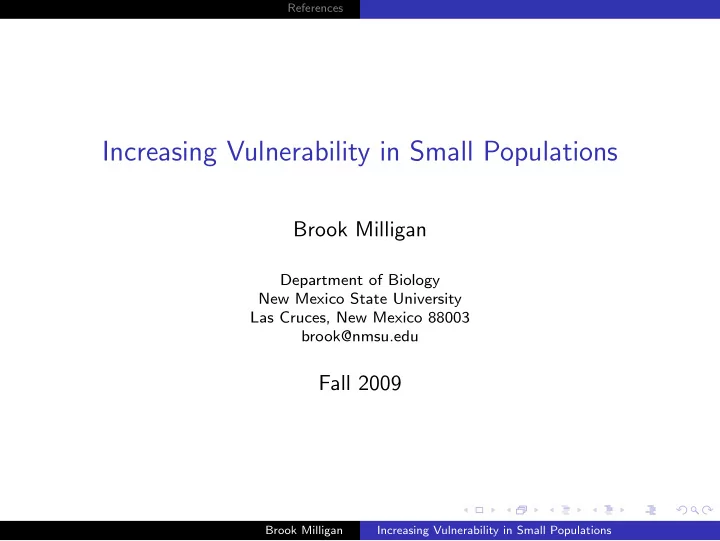

References Increasing Vulnerability in Small Populations Brook Milligan Department of Biology New Mexico State University Las Cruces, New Mexico 88003 brook@nmsu.edu Fall 2009 Brook Milligan Increasing Vulnerability in Small Populations
References Designation versus protection Recognition of species at risk 9 IUCN categories can lead to official designation, e.g., Federally-listed endangered species, which conveys legal status Biological status unchanged by designation may continue to deteriorate mitigation of detrimental factors required in addition to designation Brook Milligan Increasing Vulnerability in Small Populations
References Core Concepts Core concepts Minimum viable population size (MVP) Minimum dynamic area (MDA) Populations below a certain threshold exhibit much higher probability of extinction, while those above are much more likely to persist Brook Milligan Increasing Vulnerability in Small Populations
References MVP: Bighorn Sheep Brook Milligan Increasing Vulnerability in Small Populations
References MVP: Channel Island Birds Brook Milligan Increasing Vulnerability in Small Populations
References MVP: Ipomopsis aggregata Brook Milligan Increasing Vulnerability in Small Populations
References Which Factors Cause Extinction? Heath hen: Tympanuchus cupido cupido Once fairly common from New England to Virginia Declined steadily with European settlement 1876: remained only on Martha’s Vineyard 1900: fewer than 100 survivors 1907: refuge on Martha’s Vineyard and predator control 1916: increase to over 800 birds 1916: fire destroyed most nests and habitat 1916 winter: high predation by goshawks ( Accipiter gentilis ) 1917: reduced population to 100–150 individuals 1920: 200 individuals, but disease reduced population to below 100 1920s: increasingly sterile, male skewed sex ratio 1932: extinct Brook Milligan Increasing Vulnerability in Small Populations
References General Use of MVP and MDA Result: quantitative assessment of risk in face of uncertainty and stochasticity as a function of population size Analogous to flood prediction Framework for evaluating alternative management options Factors leading to population decline and extinction (Shaffer, 1981) demographic fluctuation environmental fluctuation loss of genetic variability Brook Milligan Increasing Vulnerability in Small Populations
References MVP and Types of Stochasticity Brook Milligan Increasing Vulnerability in Small Populations
References Demographic Stochasticity Variation among individuals in survival or reproductive success “Arises from chance events in the survival and reproductive success of a finite number of individuals” (Shaffer, 1981) Measurable as the variance in fitness among individuals compared with the mean of the population Brook Milligan Increasing Vulnerability in Small Populations
References Environmental Stochasticity and Natural Catastrophes Temporal variation in survival or reproductive success affecting entire population Two types environmental stochasticity “due to temporal variation of habitat parameters and the populations of competitors, predators, parasites, and diseases” (Shaffer, 1981) measurable as the variance through time in the population mean fitness natural catastrophes “such as floods, fires, droughts, etc., which may occur at random intervals through time” (Shaffer, 1981) measurable as the variance through time in mean across populations Brook Milligan Increasing Vulnerability in Small Populations
References Loss of Genetic Variability Inbreeding: increase in common ancestry Heterozygosity: decline in variation Effective population size: N e Inbreeding depression: decrease in fitness Brook Milligan Increasing Vulnerability in Small Populations
References Loss of Genetic Variability: Inbreeding Increase of homozygosity or identity by descent � 1 � F ( t + 1) = F ( t )(1) + (1 − F ( t )) (1) 2 N e � 1 � ∆ F ( t ) = (1 − F ( t )) (2) 2 N e Brook Milligan Increasing Vulnerability in Small Populations
References Loss of Genetic Variability: Heterozygosity Loss of heterozygosity � � 1 H ( t + 1) = 1 − H ( t ) 2 N e = λ H ( t ) (3) ∆ H = H ( t + 1) − H ( t ) � 1 � = 1 − H ( t ) − H ( t ) 2 N e − 1 = (4) 2 N e � t � 1 H ( t ) = 1 − H (0) 2 N e λ t H (0) = � � − t H (0) exp (5) ≈ 2 N e Brook Milligan Increasing Vulnerability in Small Populations
References Loss of Heterozygosity Brook Milligan Increasing Vulnerability in Small Populations
References Loss of Genetic Variability: Effective Population Size Effective population size: N e unequal sex ratio N e = 4 N m N f (6) N m + N f variation in reproductive output population fluctuation t 1 1 1 � = (7) N e t N i i =1 � 1 1 1 10 + 1 100 + 1 1 20 + 1 � = 20 + 5 10 N e 1 5 · 31 = 100 1 = (8) 16 . 1 Brook Milligan Increasing Vulnerability in Small Populations
References Effective Population Size Brook Milligan Increasing Vulnerability in Small Populations
References Loss of Genetic Variability: Inbreeding Depression Inbreeding leads to greater homozygosity Increased homozygosity exposes more recessive deleterious alleles Greater expression of recessive deleterious alleles leads to reduction in fitness Brook Milligan Increasing Vulnerability in Small Populations
References Inbreeding Depression Brook Milligan Increasing Vulnerability in Small Populations
References Inbreeding Depression Brook Milligan Increasing Vulnerability in Small Populations
References Detrimental Positive Feedback: Extinction Vortices Any reduction in population size increases probability of further reductions increases demographic stochasticity increases vulnerability to environmental stochasticity increases loss of genetic variation Example: mutational meltdown fixation of deleterious alleles reduction in population growth rate increased risk of fixation of deleterious alleles Brook Milligan Increasing Vulnerability in Small Populations
References Shaffer, M. L. 1981. Minimum population sizes for species conservation. BioScience , 31:131–134. Brook Milligan Increasing Vulnerability in Small Populations
Recommend
More recommend